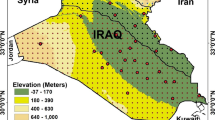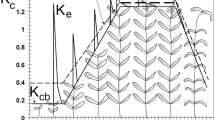Abstract
The seasonal variability in the surface energy exchange of an alpine grassland on the eastern Qinghai-Tibetan Plateau was investigated using eddy covariance measurements. Based on the change of air temperature and the seasonal distribution of precipitation, a winter season and wet season were identified, which were separated by transitional periods. The annual mean net radiation (R n) was about 39 % of the annual mean solar radiation (R s). R n was relatively low during the winter season (21 % of R s) compared with the wet season (54 % of R s), which can be explained by the difference in surface albedo and moisture condition between the two seasons. Annually, the main consumer of net radiation was latent heat flux (LE). During the winter season, sensible heat flux (H) was dominant because of the frozen soil condition and lack of precipitation. During the wet season, LE expended 66 % of R n due to relatively high temperature and sufficient rainfall coupled with vegetation growth. Leaf area index (LAI) had important influence on energy partitioning during wet season. The high LAI due to high soil water content (θ v) contributed to high surface conductance (g c) and LE, and thus low Bowen ratio (β). LE was strongly controlled by R n from June to August when g c and θ v were high. During the transitional periods, H and LE were nearly equally partitioned in the energy balance. The results also suggested that the freeze–thaw condition of soil and the seasonal distribution of precipitation had important impacts on the energy exchange in this alpine grassland.
摘要
文利用观测数据分析研究了玛曲草原地表能量交换的季节变化特征。玛曲草原年均净辐射占年均入射太阳辐射的39 %,冬季净辐射占入射太阳辐射的21 %,雨季净辐射占入射太阳辐射的54 %。冬季和雨季净辐射的不同占比主要由2个季节的地表反照率和湿度状况的差异引起。全年来看,潜热通量是净辐射的主要消耗者。冬季由于土壤冻结加之降水稀少,感热通量在能量分配中占据主导地位。而雨季相对较高的气温、充足的降水及植被茂盛的生长力使得潜热通量占主导地位。在4月和10月这2个过渡季,感热通量和潜热通量在能量分配中具有相近的占比。









Similar content being viewed by others
References
Eugster W, Rouse WR, Pielke RA Sr et al (2000) Land-atmosphere energy exchange in Arctic tundra and boreal forest: available data and feedbacks to climate. Glob Change Biol 6:84–115
Raupach MR (1998) Influences of local feedbacks on land-air exchanges of energy and carbon. Glob Change Biol 4:477–494
Amiro BD, Barr AG, Black TA et al (2006) Carbon, energy and water fluxes at mature and disturbed forest sites, Saskatchewan, Canada. Agric For Meteorol 136:237–251
Baldocchi DD (2003) Assessing the eddy covariance technique for evaluating carbon dioxide exchange rates of ecosystems: past, present and future. Glob Change Biol 9:479–492
Krishnana P, Meyersa TP, Scottb RL et al (2012) Energy exchange and evapotranspiration over two temperate semi-arid grasslands in North America. Agric For Meteorol 153:31–44
Wilson KB, Baldocchi DD, Aubinet M et al (2002) Energy partitioning between latent and sensible heat flux during the warm season at FLUXNET sites. Water Resour Res 38:30–31
Ma Y, Fan S, Ishikawa H et al (2005) Diurnal and inter-monthly variation of land surface heat fluxes over the central Tibetan Plateau area. Theor Appl Climatol 80:259–273
Yanai M, Li C, Song Z (1992) Seasonal heating of the Tibetan Plateau and its effects on the evolution of the Asian summer monsoon. J Meteorol Soc Jpn 70:319–351
Ye DZ, Gao YX (1979) The meteorology of the Qinghai-Xizang (Tibetan) Plateau. Science Press, Beijing
Yanai M, Wu GX (2006) Effects of the Tibetan Plateau. In: Wang B (ed) The Asian monsoon. Springer, New York, pp 513–549
Ma Y, Menenti M, Feddes R et al (2008) Analysis of the land surface heterogeneity and its impact on atmospheric variables and the aerodynamic and thermodynamic roughness lengths. J Geophys Res 113:D8113
Ding Y (1992) Effects of the Qinghai-Xizang (Tibetan) Plateau on the circulation features over the plateau and its surrounding areas. Adv Atmos Sci 9:112–130
Riehl H (1967) Southeast Asia monsoon study. Doctoral Dissertation, Colorado State University
Ding MJ, Zhang YL, Sun XM et al (2013) Spatiotemporal variation in alpine grassland phenology in the Qinghai-Tibetan Plateau from 1999 to 2009. Chin Sci Bull 58:396–405
Flohn H (1968) Contributions to a meteorology of the Tibetan Highlands. Doctoral Dissertation, Colorado State University
Luo H, Yanai M (1984) The large-scale circulation and heat sources over the Tibetan Plateau and surrounding areas during the early summer of 1979. Part II: heat and moisture budgets. Mon Weather Rev 112:966–989
Tanaka K, Ishikawa H, Hayashi T et al (2001) Surface energy budget at Amdo on the Tibetan Plateau using GAME/Tibetan IOP98 data. J Meteorol Soc Jpn 79:505–517
Ding M, Zhang Y, Liu L et al (2007) The relationship between NDVI and precipitation on the Tibetan Plateau. J Geogr Sci 17:259–268
Zheng D (1996) The system of physico-geographical regions of the Qinghai-Xizang (Tibetan) Plateau. Sci China Ser D-Earth Sci 39:410–417
Kljun N, Calanca P, Rotach MW et al (2004) A simple parameterisation for flux footprint predictions. Bound Layer Meteorol 112:503–523
LI-COR, Inc. (2013) EddyPro® 5 help and user’s guide. LI-COR, Inc., Lincoln
Vickers D, Mahrt L (1997) Quality control and flux sampling problems for tower and aircraft data. J Atmos Ocean Technol 14:512–526
Wilczak JM, Oncley SP, Stage SA (2001) Sonic anemometer tilt correction algorithms. Bound Layer Meteorol 99:127–150
Schotanus P, Nieuwstadt F, Bruin HAR (1983) Temperature measurement with a sonic anemometer and its application to heat and moisture fluxes. Bound Layer Meteorol 26:81–93
Moncrieff JB, Massheder JM, De Bruin H et al (1997) A system to measure surface fluxes of momentum, sensible heat, water vapour and carbon dioxide. J Hydrol 188–189:589–611
Webb EK, Pearman GI, Leuning R (1980) Correction of flux measurements for density effects due to heat and water vapour transfer. Q J R Meteorol Soc 106:85–100
Liebethal C, Huwe B, Foken T (2005) Sensitivity analysis for two ground heat flux calculation approaches. Agric For Meteorol 132:253–262
de Vries DA (1963) Thermal properties of soils. In: van Wijk WR (ed) Physics of plant environment. North-Holland Publishing Company, Amsterdam, pp 210–235
Mauder M, Foken T (2004) Documentation and instruction manual of the eddy covariance software package TK2. Work Report University of Bayreuth, Department of Micrometeorology
Papale D, Reichstein M, Aubinet M et al (2006) Towards a standardized processing of Net Ecosystem Exchange measured with eddy covariance technique: algorithms and uncertainty estimation. Biogeosciences 3:571–583
Falge E, Baldocchi D, Olson R et al (2001) Gap filling strategies for defensible annual sums of net ecosystem exchange. Agric For Meteorol 107:43–69
Reichstein M, Falge E, Baldocchi D et al (2005) On the separation of net ecosystem exchange into assimilation and ecosystem respiration: review and improved algorithm. Glob Change Biol 11:1424–1439
Monteith JL, Unsworth MH (1990) Principles of environmental physics. Edward Arnold, London
Jarvis PG, McNaughton KG (1986) Stomatal control of transpiration: scaling up from leaf to region. In: Kozlowski TT (ed) Advances in ecological research, vol 15. Academic Press, London, pp 1–49
Zhao X, Liang S, Liu S et al (2013) The global land surface satellite (GLASS) remote sensing data processing system and products. Remote Sens 5:2436–2450
Wilson K, Goldstein A, Falge E et al (2002) Energy balance closure at FLUXNET sites. Agric For Meteorol 113:223–243
Mahrt L (1998) Flux sampling errors for aircraft and towers. J Atmos Ocean Technol 15:416–429
Baldocchi D, Kelliher FM, Black TA et al (2000) Climate and vegetation controls on boreal zone energy exchange. Glob Change Biol 6:69–83
Foken T (2008) The energy balance closure problem: an overview. Ecol Appl 18:1351–1367
Idso SB, Jackson RD, Reginato RJ et al (1975) The dependence of bare soil albedo on soil water content. J Appl Meteorol 14:109–113
Eltahir EAB (1998) A soil moisture-rainfall feedback mechanism 1. Theory and observations. Water Resour Res 34:765–776
Gu S, Tang Y, Cui X et al (2005) Energy exchange between the atmosphere and a meadow ecosystem on the Qinghai-Tibetan Plateau. Agric For Meteorol 129:175–185
Chen S, Chen J, Lin G et al (2009) Energy balance and partition in Inner Mongolia steppe ecosystems with different land use types. Agric For Meteorol 149:1800–1809
Saigusa N, Oikawa T, Liu S (1998) Seasonal variations of the exchange of CO2 and H2O between a grassland and the atmosphere: an experimental study. Agric For Meteorol 89:131–139
Wilson K, Baldocchi D (2000) Seasonal and interannual variability of energy fluxes over a broadleaved temperate deciduous forest in North America. Agric For Meteorol 100:1–18
Valentini R, Gamon JA, Field CB (1995) Ecosystem gas exchange in a California grassland: seasonal patterns and implications for scaling. Ecology 76:1940–1952
Wever LA, Flanagan LB, Carlson PJ (2002) Seasonal and interannual variation in evapotranspiration, energy balance and surface conductance in a northern temperate grassland. Agric For Meteorol 112:31–49
Acknowledgments
This work was supported by the National Basic Research Program of China (2010CB951701, 2011CB952002), the National Natural Science Foundation of China (41205006, 41275016), and the Foundation for Excellent Youth Scholars of CAREERI, Chinese Academy of Sciences. We sincerely thank Xiaohui Peng and Tianning Chen for their contribution in the field work.
Conflict of interest
The authors declare that they have no conflict of interest.
Author information
Authors and Affiliations
Corresponding author
About this article
Cite this article
Shang, L., Zhang, Y., Lü, S. et al. Energy exchange of an alpine grassland on the eastern Qinghai-Tibetan Plateau. Sci. Bull. 60, 435–446 (2015). https://doi.org/10.1007/s11434-014-0685-8
Received:
Accepted:
Published:
Issue Date:
DOI: https://doi.org/10.1007/s11434-014-0685-8




